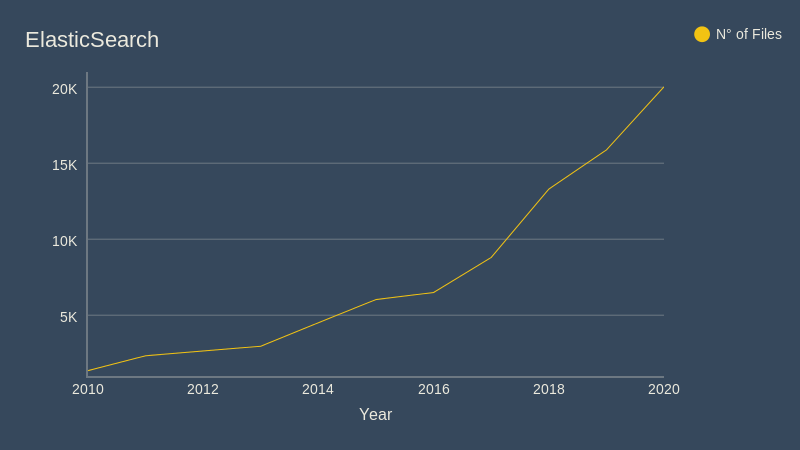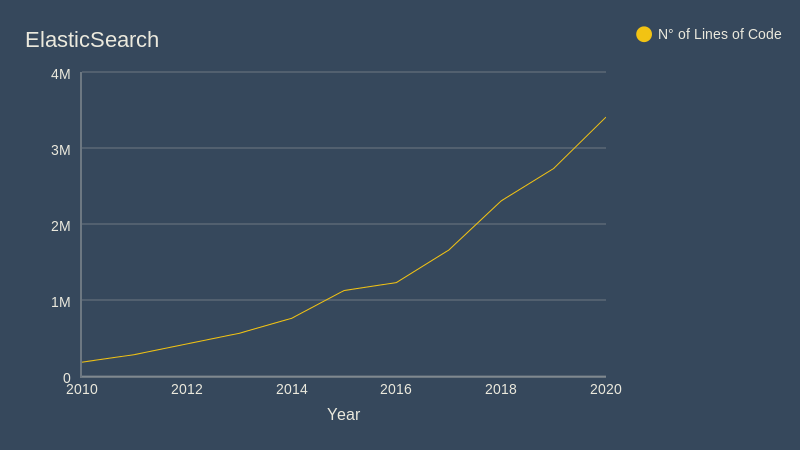ElasticSearch - Evolution
1. History and Evolution
1.1 Main Functional Differences
Even from the begining, Elasticsearch was a search engine with different features:
- Distributed and Highly Available Search Engine.
- Each index is fully sharded with a configurable number of shards.
- Each shard can have one or more backups.
- Read / Search operations performed on either primary or backup shards.
- Multi Tenant with Multi Types.
- Support for more than one index.
- Support for more than one type per index.
- Index level configuration (number of shards, index storage, …).
- Various set of APIs
- HTTP RESTful API
- Native Java API.
- All APIs perform automatic node operation rerouting.
- Document oriented
- No need for upfront schema definition.
- Schema can be defined per type for customization of the indexing process.
- Reliable, Asynchronous Write Behind for long term persistency.
- (Near) Real Time Search.
- Built on top of Lucene
- Each shard is a fully functional Lucene index
- All the power of Lucene easily exposed through simple configuration / plugins.
- Per operation consistency
- Single document level operations are atomic, consistent, isolated and durable.
- Open Source under Apache 2 License.
And now, it hasn’t really change it’s main functionality, but has added quality ones. The list of actual features is the next one:
- Scalability and resiliency
- Clustering and high availability
- Automatic node recovery
- Automatic data rebalancing
- Horizontal scalability
- Rack awareness
- Cross-cluster replication
- Cross-datacenter replication
- Management
- Index lifecycle management
- Hot-warm architecture
- Frozen indices
- Snapshot lifecycle management
- Snapshot and restore
- Source-only snapshots
- Data rollups
- Data streams
- Transforms
- Upgrade Assistant API
- API key management
- Security
- Elasticsearch secure settings
- Encrypted communications
- Encryption at rest support
- Role-based access control (RBAC)
- Attribute-based access control (ABAC)
- Field- and document-level security
- Audit logging
- IP filtering
- Security realms
- Single sign-on (SSO)
- Third-party security integration
- Alerting
- Highly available, scalable alerting
- Notifications via email, Slack, PagerDuty, ServiceNow, or webhooks
- Clients
- Language clients
- Elasticsearch DSL
- Elasticsearch SQL
- Event Query Language (EQL)
- JDBC client
- ODBC client
- Tableau Connector for Elasticsearch
- CLI tools
- REST APIs
- Document APIs
- Search APIs
- Aggregations APIs
- Ingest APIs
- Management APIs
- Integrartions
- Elasticsearch-Hadoop
- Apache Hive
- Apache Pig
- Apache Spark
- Apache Storm
- Business intelligence (BI)
- Plugins and integrations
- Deployment
- Download and install
- Elastic Cloud
- Elastic Cloud Enterprise
- Elastic Cloud on Kubernetes
- Helm Charts
- Docker containerization
1.2 Evolution in Numbers
For the following Charts, the following versions of the ElasticSearch repository were used (with their corresponding attributes):
- v0.4 (2010)
- Files: 1.350
- Lines of Code: 181.946
- Commit: b3337c312765e51cec7bde5883bbc0a08f56fb65
- v0.15 (2011)
- Files: 2.329
- Lines of Code: 280.801
- Commit: dac2a888fbd4a1fbff50efe3d6600ce2ed0bb95b
- v0.90 GA (2013)
- Files: 2.957
- Lines of Code: 561.527
- Commit: cb75ce0caa65af294167ae0d1514deec7815431b
- v1.0.0 (2014)
- Files: 4.501
- Lines of Code: 758.745
- Commit: a46900e9c72c0a623d71b54016357d5f94c8ea32
- v2.0.0-beta1 (2015)
- Files: 6.027
- Lines of Code: 1.123.593
- Commit: bfa3e47383d0adc690329a2fa1094ceb64cae651
- v2.3.5 (2016)
- Files: 6.492
- Lines of Code: 1.229.010
- Commit: 90f439ff60a3c0f497f91663701e64ccd01edbb4
- v5.5.0 (2017)
- Files: 8.796
- Lines of Code: 1.657.088
- Commit: 260387d2e4c0422c00adb04d160690ed1da05209
- v6.4.0 (2018)
- Files: 13.292
- Lines of Code: 2.303.684
- Commit: 595516e45d054483dcdaf12f0468a59cb34bb568
- v6.8.5 (2019)
- Files: 15.868
- Lines of Code: 2.729.228
- Commit: 78990e93431aebcc3dcd7fa20fab4b5b29ab7988
- v7.9.3 Last GitHub Build (2020)
- Files: 20.022
- Lines of Code: 3.406.533
- Commit: c4138e51121ef06a6404866cddc601906fe5c868


2. Architecture Decision Records
ADR1: Apache Lucene as base search software
Context: (1st commit)
- An esqueleton is needed to develop the software
- Apache Lucene is a search software, that includes Lucene Core (Java library with indexing and search features) and Solr, a search server.
Decision: Use Apache Lucene as the base software for the Elasticsearch project
Status: Implemented
Consequences:
- 10 years after, it is still the base software used by ElasticSearch.
- Easy to use and construct over it.
- Apache Lucene has continuous updates that make the project to never get deprecated in its core
ADR2: Implement Hamcrest matcher library
Context: (1st commit)
- Because ElasticSearch is a small software, it can use external libraries for complex algorithms without losing performance.
- Hamcrest provides a matcher for different types of data structures (from simple text to collections and objects).
Decision: Use the Hamcrest library to find matching results to the query.
Status: Implemented
Consequences:
- In the begining, it was a good tool for a much smaller software like what ElasticSearch was 10 years ago.
- Today Hamcrest is mainly used in testing, where the performance is not important.
ADR3: Use Google Collect
Context: (1st commit)
- Google Collect provides different tools and functions to make it easy to program in Java.
Decision: Use the Google Collect library for different purposes in code.
Status: Implemented
Consequences: Google Collect changed it’s name and now is Guava, but the tool is still used in different parts of the software.
ADR4: Use Docker to Install ElasticSearch
Context: (~v5.0.0)
- Docker provides an easy way to deploy software in different types of Operative Systems
- ElasticSearch should provide installation methods that adapt to the most quantity of users as possible
Decision: We will use Docker to provide the option to install images of ElasticSearch
Status: Implemented
Consequences:
- Installing ElasticSearch as a Docker image allows to create single or multi node clusters in an easy way
- Users can have multiple instances or versions of ElasticSearch
- Docker gives an easy way to use ElasticSearch in production environments
ADR5: Create ElasticSearch images using centos as the base image
Context: (~v5.0.0)
- ElasticSearch images need a base OS image to have an easier way to work wth Docker
- ElasticSearch images should last in time with good maintenance and must have good security
Decision:
- We will use centos:7 to provide a base for the ElasticSearch images
Status: Implemented
Consequences:
- centos:7 is one of the latest releases of its kind, so it receives good maintenance and support
- Implementation of the image is easy as centos has a lot of documentation
- centos management panel support makes ElasticSearch images to host multiple sites on the server in an easier way